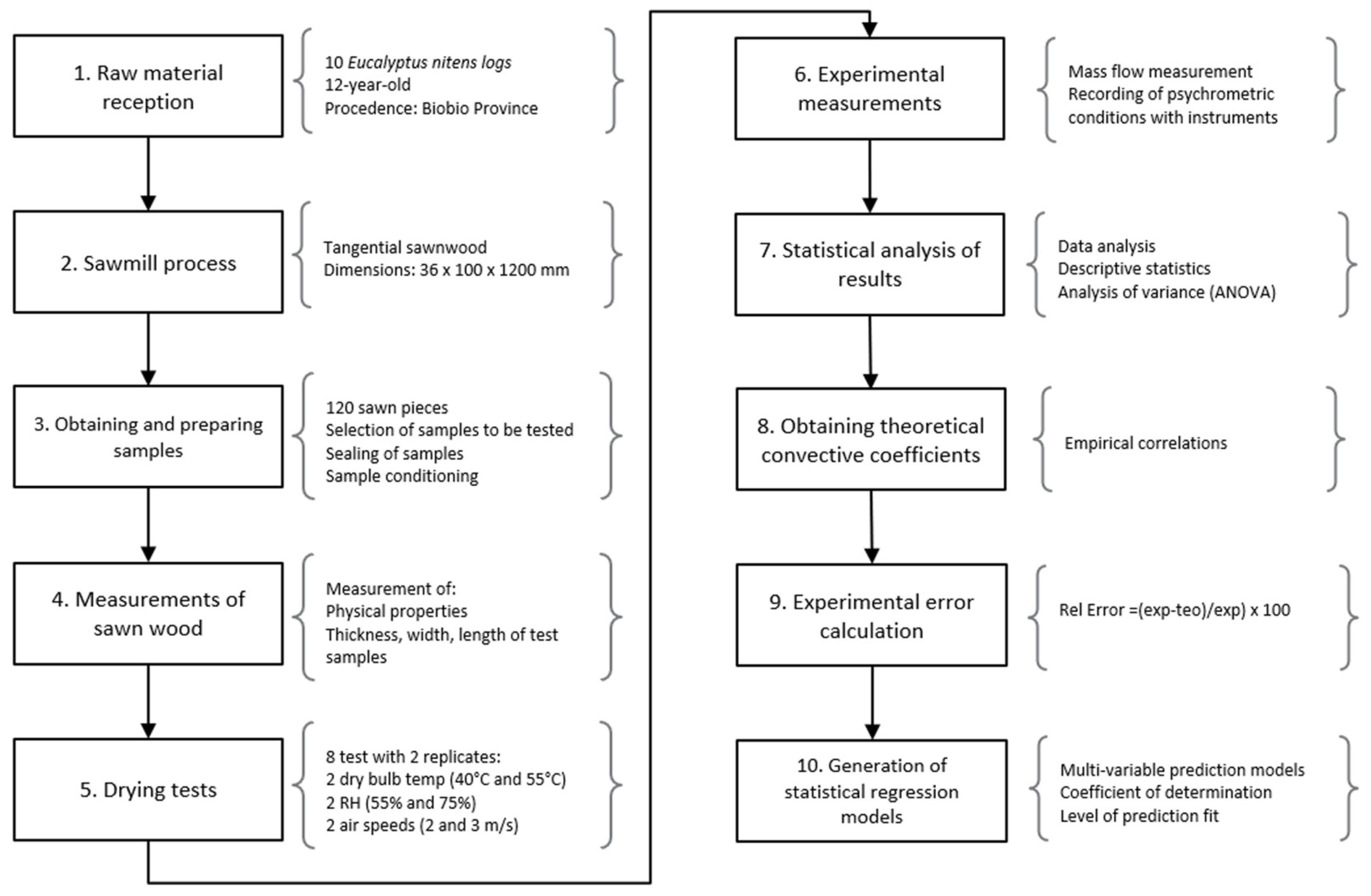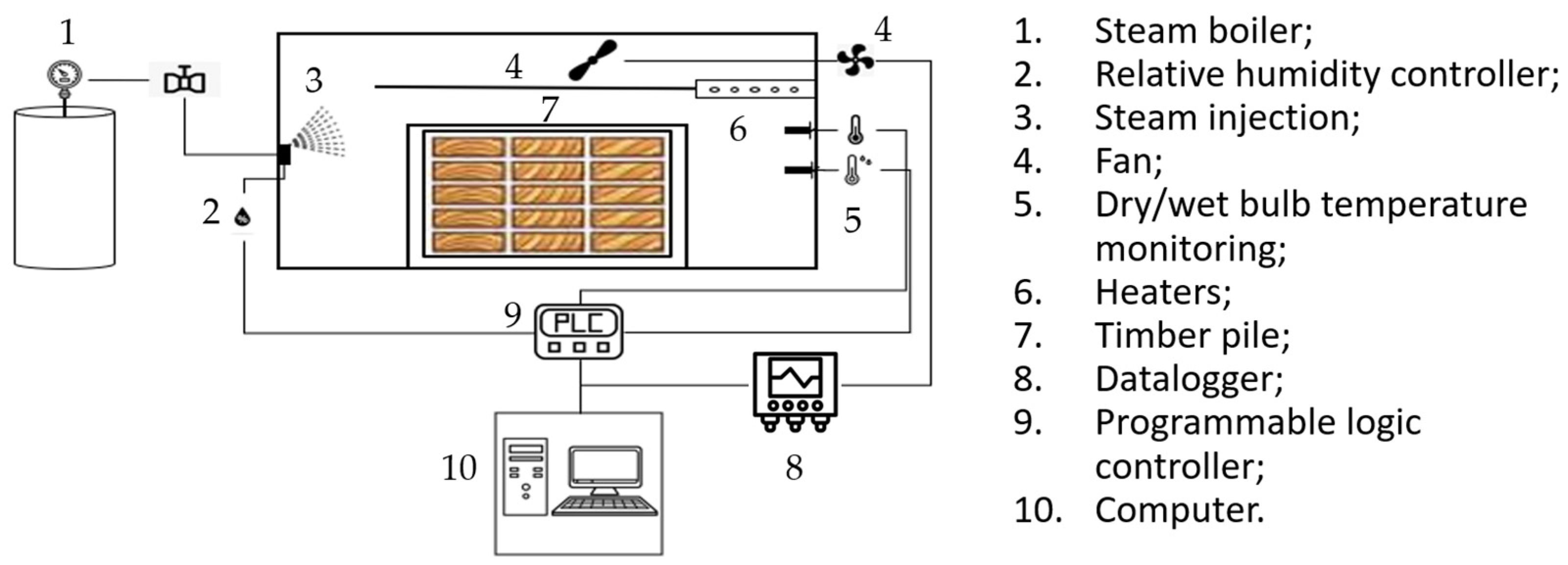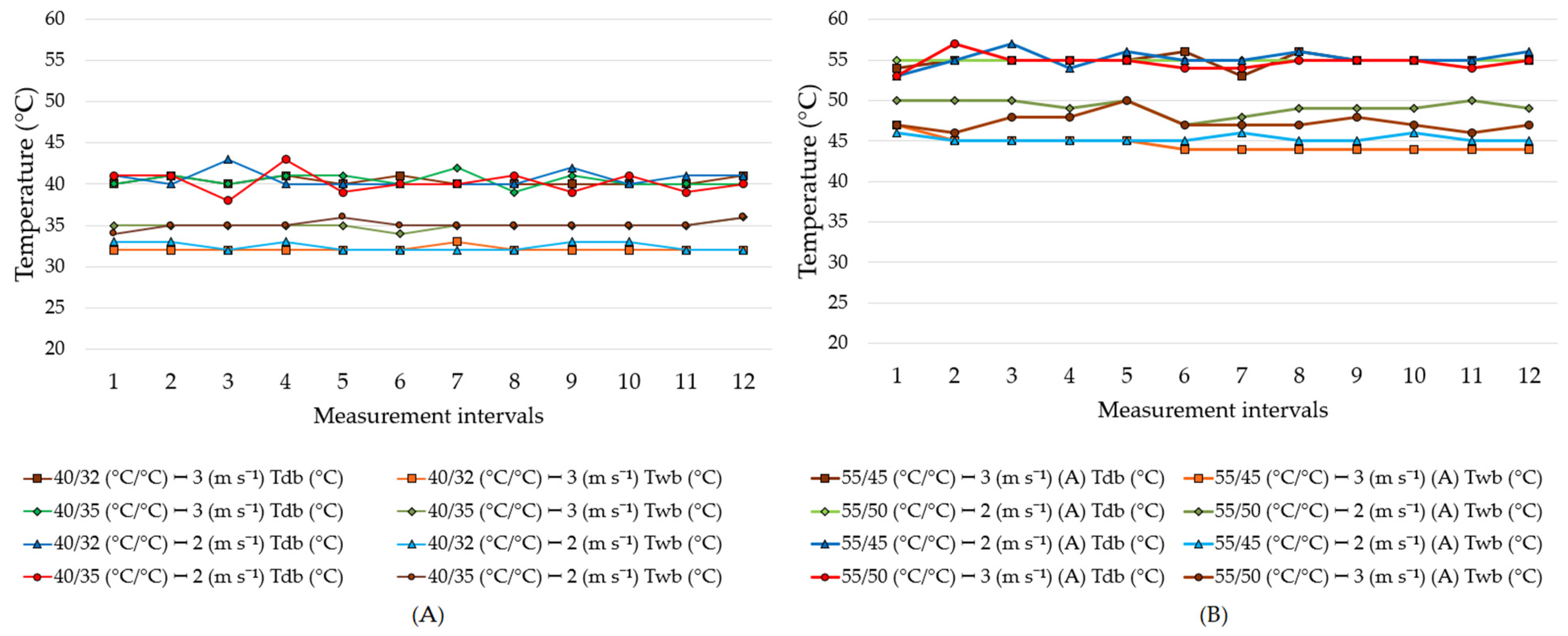Experimental and Statistical Determination of Convective Heat and Mass Transfer Coefficients for Eucalyptus nitens Sawn Wood Drying
Abstract
:1. Introduction
2. Materials and Methods
2.1. Origin and Sample Preparation
2.2. Experimental Design
2.3. Drying Process
2.4. Measurement of Mass Flow during Drying
2.5. Experimental Determination of Convective Heat and Mass Transfer Coefficients
- = Convective heat transfer coefficient (W m−2 K−1);
- = Convective mass heat transfer coefficient (m s−1);
- = Convective mass flow (kg m−2 s−1);
- = Convective heat flow (kg m−2);
- = Latent heat of vaporization (J kg−1) at Twb;
- = Dry bulb temperature (°C);
- = Wet bulb temperature (°C);
- = Evaporated water flow (kg s−1 m−2);
- = Absolute humidity at a given Tdb y pv (kg m−3);
- = AH of the drying (kg m−3);
- = AH in control piece at Twb, equal to saturation absolute humidity (kg m−3);
- = Partial pressure of water vapor at Tdb (Pa);
- = Partial pressure of vapor at given drying conditions (Pa).
2.6. Calculation of Convective Coefficients by Empirical Correlation
- = Convective heat coefficient (W m−2 K−1);
- = Convective mass coefficient (m s−1);
- = Thermal conductivity of the air–vapor mixture (J s−1 m−1 K−1);
- = Hydraulic diameter (m);
- = Density of the air–vapor mixture (kg m−3);
- = Specific heat of the air–vapor mixture (J kg−1 K−1);
- = Chilton-Colburn analogy for heat transfer;
- = Dimensionless Nusselt number;
- = Dimensionless Reynolds number;
- = Dimensionless Prandtl number;
- = Dimensionless Sherwood number;
- = Dimensionless Schmidt number;
- = Diffusivity of water vapor in air (m−2 s−1);
- Va = Air velocity (m s−1);
- = Heat and mass transfer surface area (m);
- = Viscosity of the air–vapor mixture (Pa s);
- = Velocity of the air–vapor mixture (m s−1);
- = Cross-sectional area (m2) of the control piece;
- = Cross-sectional perimeter (m) of the control piece.
2.7. Statistical Analysis
- = Multivariable regression statistical model where; i-th convective coefficient obtained at the j-th dry bulb temperature, k-th relative humidity, and n-th air velocity, Ɐi: 1, 2; hc = 1, km = 2;
- = j-th dry bulb temperature (°C), Ɐj: 40, …, 55;
- = k-th relative humidity (%); Ɐk: 55, …, 75;
- = n-th air velocity (m s−1), Ɐn: 2, …, 3;
- = Residual error;
- = Model parameters.
- = Relative error between the experimental value and the empirical correlation (%);
- = Convective heat coefficient (W m−2 K−1) or experimental mass (m s−1);
- = Convective heat coefficient (W m−2 K−1) or mass (m s−1) obtained by the empirical correlation.
3. Results and Discussion
3.1. Isothermal Drying Process
3.2. Convective Heat Transfer Coefficients
3.3. Convective Mass Transfer Coefficient
3.4. Modeling of Convective Heat and Mass Transfer Coefficients
4. Conclusions
Author Contributions
Funding
Data Availability Statement
Acknowledgments
Conflicts of Interest
References
- Zhao, J.; Fu, Z.; Jia, X.; Cai, Y. Modeling Conventional Drying of Wood: Inclusion of a Moving Evaporation Interface. Dry. Technol. 2016, 34, 530–538. [Google Scholar] [CrossRef]
- Salin, J. External Heat and Mass Transfer—Some Remarks. In Proceedings of the 8th International IUFRO Wood Drying Conference, Brasov, Romania, 24–29 August 2003. [Google Scholar]
- Sargent, R.; Riley, S.; Schöttle, L. Measurement of Dynamic Sorption Behaviour of Small Specimens of Pinus radiata—Influence of Wood Type and Moisture Content on Difusion Rate. Maderas Cienc. Tecnol. 2010, 12, 93–103. [Google Scholar] [CrossRef]
- Salin, J.G. Inclusion of the Sorption Hysteresis Phenomenon in Future Drying Models. Some Basic Considerations. Maderas Cienc. Tecnol. 2011, 13, 173–182. [Google Scholar] [CrossRef]
- Montero, C.; Rozas, C. Exploratory Study for the Characterization of the Wood Drying Rate of Eucalyptus nitens Timber, Applying Multiple Regression Models. Sci. For. Sci. 2019, 47, 105–113. [Google Scholar] [CrossRef]
- Sanchez, R. Mathematical Correlation to Get Mass Transfer Coefficient in Solids Drying. Maderas Cienc. Tecnol. 2007, 9, 245–258. [Google Scholar]
- Haque, M.N. Analysis of Heat and Mass Transfer during High Temperature Drying of Pinus radiata. Dry. Technol. 2007, 25, 379–389. [Google Scholar] [CrossRef]
- Rozas, C. Modelo de Transferência de Calor e Massa Na Secagem de Madeira Serrada de Pinus. Ph.D. Thesis, Universidade Federal do Paraná, Curitiba, Brazil, 2007. [Google Scholar]
- He, Z.; Zhao, Z.; Zhang, Y.; Lv, H.; Yi, S. Convective Heat and Mass Transfer during Vacuum Drying Process. Wood Res. 2015, 60, 929–938. [Google Scholar]
- Skuratov, N.; Sapozhnikov, I.; Alexeeva, I. Measurements during Wood Drying Based on X-ray and Slicing Tecnhiques and Computation of Diffusion Coefficients. Pro Ligno 2015, 11, 383–388. [Google Scholar]
- Ratanawilai, T.; Nuntadusit, C.; Promtong, N. Drying Characteristics of Rubberwood by Impinging Hot-Air and Microwave Heating. Wood Res. 2015, 60, 59–70. [Google Scholar]
- Montero, C.; Rozas, C.; Picarte, C. Simulación Del Secado En Madera de Eucalyptus nitens Usando Modelos de Difusión Bajo Condiciones Unidimensionales e Isotérmicas. Sci. For. 2020, 48, e2957. [Google Scholar] [CrossRef]
- Siau, J. Wood: Influence of Moisture on Physical Properties; Department of Wood Science and Forest Products, Virginia Polytechnic Institute and State University: Blacksburg, VA, USA, 1995; 227p. [Google Scholar]
- Hrčka, R.; Babiak, M. Wood Thermal Properties. In Wood in Civil Engineering; IntechOpen: London, UK, 2017. [Google Scholar] [CrossRef]
- Zadin, V.; Kasemägi, H.; Valdna, V.; Vigonski, S.; Veske, M.; Aabloo, A. Application of Multiphysics and Multiscale Simulations to Optimize Industrial Wood Drying Kilns. Appl. Math. Comput. 2015, 267, 465–475. [Google Scholar] [CrossRef]
- Erriguible, A.; Bernada, P.; Couture, F.; Roques, M.A. Modeling of Heat and Mass Transfer at the Boundary between a Porous Medium and Its Surroundings. Dry. Technol. 2005, 23, 455–472. [Google Scholar] [CrossRef]
- Tremblay, C.; Cloutier, A.; Fortin, Y. Experimental Determination of the Convective Heat and Mass Transfer Coefficients for Wood Drying. Wood Sci. Technol. 2000, 34, 253–276. [Google Scholar] [CrossRef]
- Harris, D. An Investigation of Ambient Drying of Eucalyptus Grandis Wood. Master’s Thesis, University of Hawaii, Honolulu, HI, USA, 2016. [Google Scholar]
- Rozas, C.; Tomaselli, I.; Zanoelo, E.F. Internal Mass Transfer Coefficient during Drying of Softwood (Pinus elliottii Engelm.) Boards. Wood Sci. Technol. 2009, 43, 361–373. [Google Scholar] [CrossRef]
- Sarricolea, P.; Herrera-Ossandon, M.; Meseguer-Ruiz, Ó. Climatic Regionalisation of Continental Chile. J. Maps 2017, 13, 66–73. [Google Scholar] [CrossRef]
- NCh 176/1:2019; Madera—Parte 1: Determinación de Contenido de Humedad. Instituto Nacional de Normalización: Santiago, Chile, 2019.
- Vermaas, H.F. Drying Eucalypts for Quality: Material Characteristics, Pre-Drying Treatments, Drying Methods, Schedules and Optimisation of Drying Quality. S. Afr. For. J. 1995, 174, 41–49. [Google Scholar] [CrossRef]
- Jankowsky, I.; Dos Santos, G. Drying Behavior and Permeability of Eucalyptus Grandis Lumber. Maderas Cienc. Tecnol. 2005, 7, 17–25. [Google Scholar] [CrossRef]
- Welty, J.; Wicks, C.; Wilson, R.; Rorrer, G. Fundamentals of Momentum, Heat, and Mass Transfer; John Wiley & Sons, Inc.: Hoboken, NJ, USA, 2008; 729p. [Google Scholar]
- Nabhani, M.; Remblay, C.; Fortin, Y. Experimental Determination of Convective Heat and Mass Transfer Coefficients During Wood Drying. In Proceedings of the 8th International IUFRO Wood Drying Conference, Brasov, Romania, 24–29 August 2003; pp. 225–230. [Google Scholar]
- Pang, S. External Heat and Mass Transfer Coefficients for Kiln Drying of Timber. Dry. Technol. 1996, 14, 859–871. [Google Scholar] [CrossRef]
- Hukka, A. The Effective Diffusion Coefficient and Mass Transfer Coefficient of Nordic Softwoods as Calculated from Direct Drying Experiments. Holzforschung 1999, 53, 534–540. [Google Scholar] [CrossRef]
- Simpson, W.; Liu, J. Dependence of the Water Vapor Diffusion Coefficient of Aspen (Populus Spec.) on Moisture Content. Wood Sci. Technol. 1991, 26, 9–21. [Google Scholar] [CrossRef]
- Simpson, W.; Liu, J. An Optimization Technique to Determine Red Oak Surface and Internal Moisture Transfer Coefficients during Drying. Wood Fiber Sci. 1997, 29, 312–318. [Google Scholar]
- Daza-Gómez, M.; Gómez, C.; Gómez, J.; Ratkovich, N. 3D Computational Fluid Dynamics Analysis of a Convective Drying Chamber. Processes 2022, 10, 2721. [Google Scholar] [CrossRef]
- Maier, L.; Brosch, S.; Gaehr, M.; Linkhorst, J. Convective Drying of Porous Media: Comparison of Phase—Field Simulations with Microfluidic Experiments. Transp. Porous Media 2024, 151, 559–583. [Google Scholar] [CrossRef]




| Dry Bulb Temperature (Tdb) (°C) | Relative Humidity (RH) (%) | Air Velocity (Vair) (m s−1) |
|---|---|---|
| 55 | 75 | 3 |
| 55 | 55 | 3 |
| 55 | 75 | 2 |
| 55 | 55 | 2 |
| 40 | 75 | 3 |
| 40 | 55 | 3 |
| 40 | 75 | 2 |
| 40 | 55 | 2 |
| Tdb (°C) | RH (%) | Vair m s−1 | n | Mean ** (±SD) (W m−2·K−1) | CV (%) | Min | Max | IC | CE | Erel ** |
|---|---|---|---|---|---|---|---|---|---|---|
| 55 | 75 | 3 | 30 | 25.50 (4.28) A | 16.8 | 17.15 | 29.18 | 23.77–27.22 | 16.53 | 52.4 B |
| 55 | 55 | 3 | 30 | 24.31 (2.2) AB | 9.1 | 19.73 | 27.53 | 23.42–25.19 | 16.3 | 49.5 B |
| 55 | 75 | 2 | 30 | 20.76 (3.36) B | 13.2 | 15.07 | 27.79 | 13.40–22.15 | 11.95 | 76.5 C |
| 55 | 55 | 2 | 30 | 19.30 (4.56) B | 23.1 | 13.56 | 26.89 | 17.50–21.10 | 11.78 | 63.8 BC |
| 40 | 75 | 3 | 30 | 14.31 (2.52) B | 17.7 | 9.6 | 18.79 | 13.29–15.32 | 16.82 | 16.4 A |
| 40 | 55 | 3 | 30 | 13.17 (1.79) B | 13.6 | 8.74 | 15.65 | 12.45–13.89 | 16.72 | 23.0 A |
| 40 | 55 | 2 | 30 | 10.84 (0.89) C | 8.1 | 9.41 | 12.73 | 10.49–11.19 | 12.09 | 11.2 A |
| 40 | 75 | 2 | 30 | 11.68 (0.97) C | 8.3 | 10.01 | 13.57 | 11.35–12.02 | 12.15 | 8.5 A |
| Mean Erel | 37.66 | |||||||||
| Model | Tdb | HR | Vair | |||||||
| F: | 491.01 | 1170.94 | 31.30 | 175.47 | ||||||
| p-value | <0.001 * | <0.001 * | <0.001 * | <0.001 * | ||||||
| Tdb (°C) | RH (%) | Vair m s−1 | n | Mean ** (±SD) (m s−1) | CV (%) | Min | Max | IC | CE | Erel ** |
|---|---|---|---|---|---|---|---|---|---|---|
| 55 | 75 | 3 | 22 | 0.0107 (0.0005) A | 4.3 | 0.0095 | 0.0114 | 0.0105–0.0109 | 0.0169 | 36.2 BC |
| 55 | 55 | 3 | 26 | 0.0098 (0.0009) AB | 8.8 | 0.008 | 0.0111 | 0.0094–0.0102 | 0.0168 | 41.8 AB |
| 40 | 75 | 3 | 26 | 0.0094 (0.0017) B | 17.8 | 0.0062 | 0.0122 | 0.0087–0.0101 | 0.0165 | 42.9 AB |
| 40 | 55 | 3 | 26 | 0.0091 (0.0012) B | 13.3 | 0.0061 | 0.0107 | 0.0086–0.0096 | 0.0165 | 48.4 A |
| 55 | 55 | 2 | 26 | 0.0090 (0.0019) B | 21.4 | 0.0053 | 0.0125 | 0.0082–0.0098 | 0.0122 | 26.6 D |
| 40 | 75 | 2 | 38 | 0.0080 (0.0011) C | 13.9 | 0.0062 | 0.0101 | 0.0077–0.0084 | 0.0119 | 32.7 CD |
| 55 | 75 | 2 | 26 | 0.0076 (0.0013) C | 17.5 | 0.0056 | 0.0103 | 0.0071–0.0081 | 0.0122 | 37.0 ABC |
| 40 | 55 | 2 | 26 | 0.0048 (0.0006) D | 7.7 | 0.0064 | 0.0089 | 0.0072–0.0077 | 0.0119 | 37.3 BC |
| Mean Erel | 37.86 | |||||||||
| Model | Tdb | HR | Vair | |||||||
| F | 241.20 | 10.27 | 0.21 | 424.09 | ||||||
| p-value | <0.001 * | <0.001 * | 0.6535 | <0.001 * | ||||||
| γijkn | Parameters | R2 | p-Value | |||
|---|---|---|---|---|---|---|
| −5β0 | β1 | β2 | β3 | |||
| km | 17.41 × 10−5 | 2.50 × 10−5 | - | 236.50 × 10−5 | 0.74 | <0.001 * |
| hc | −33.38 | 0.7276 | 10.51 | 4.094 | 0.89 | <0.001 * |
Disclaimer/Publisher’s Note: The statements, opinions and data contained in all publications are solely those of the individual author(s) and contributor(s) and not of MDPI and/or the editor(s). MDPI and/or the editor(s) disclaim responsibility for any injury to people or property resulting from any ideas, methods, instructions or products referred to in the content. |
© 2024 by the authors. Licensee MDPI, Basel, Switzerland. This article is an open access article distributed under the terms and conditions of the Creative Commons Attribution (CC BY) license (https://creativecommons.org/licenses/by/4.0/).
Share and Cite
Rozas, C.; Erazo, O.; Ortiz-Araya, V.; Linfati, R.; Montero, C. Experimental and Statistical Determination of Convective Heat and Mass Transfer Coefficients for Eucalyptus nitens Sawn Wood Drying. Forests 2024, 15, 1287. https://doi.org/10.3390/f15081287
Rozas C, Erazo O, Ortiz-Araya V, Linfati R, Montero C. Experimental and Statistical Determination of Convective Heat and Mass Transfer Coefficients for Eucalyptus nitens Sawn Wood Drying. Forests. 2024; 15(8):1287. https://doi.org/10.3390/f15081287
Chicago/Turabian StyleRozas, Carlos, Oswaldo Erazo, Virna Ortiz-Araya, Rodrigo Linfati, and Claudio Montero. 2024. "Experimental and Statistical Determination of Convective Heat and Mass Transfer Coefficients for Eucalyptus nitens Sawn Wood Drying" Forests 15, no. 8: 1287. https://doi.org/10.3390/f15081287






